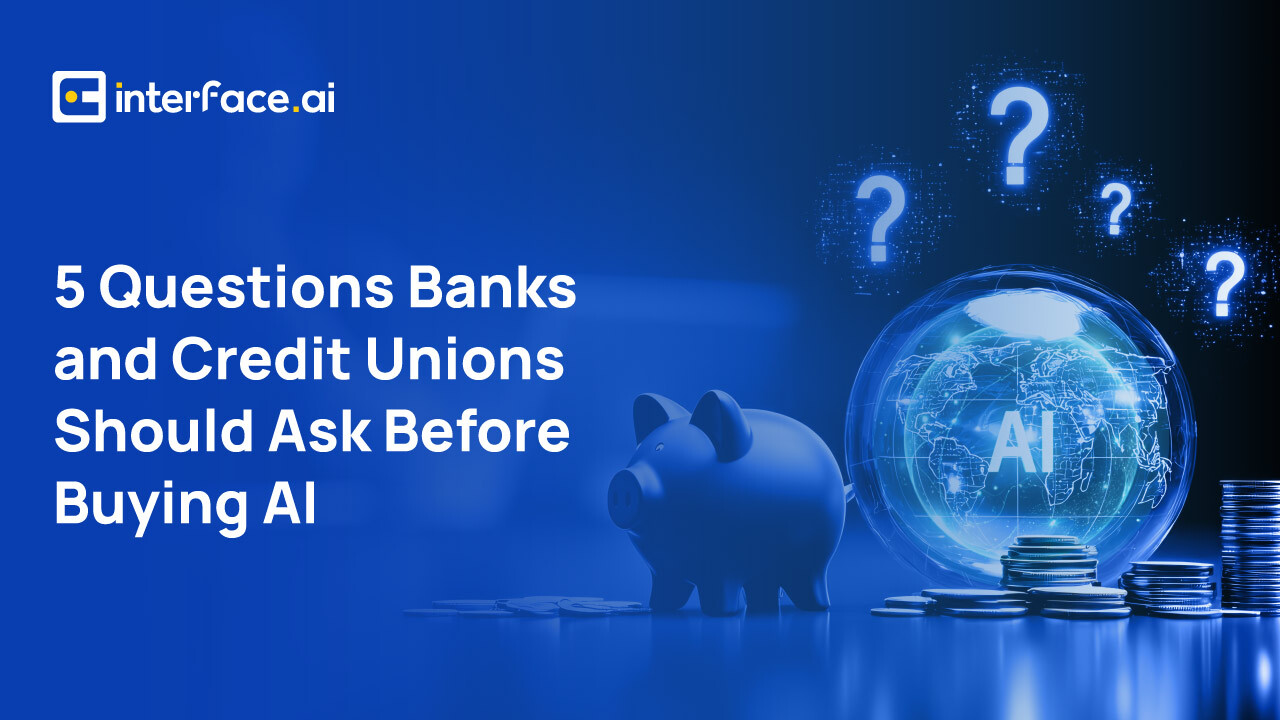
5 Questions Banks and Credit Unions Should Ask Before Buying AI
AI is no longer a “nice-to-have” in financial services. It’s quickly becoming the backbone of customer experience and operational efficiency. From automating routine interactions to detecting fraud, the opportunities are enormous.
But rushing into AI without clarity can turn promising projects into expensive experiments. Before investing, financial institutions should pause and reflect. The decision is not just about buying software – it’s about shaping the future of how you serve members, manage risk, and compete.
Here are five critical questions to ask before purchasing any AI solution.
1. What business problem am I trying to solve?
For financial institutions, the pressure to modernize is immense. Institutions are increasingly rolling out new digital services, and expectations for 24/7, seamless service are growing. But adopting AI without a clear problem statement can result in fragmented efforts and wasted budgets.
Typical business challenges where AI can create impact include:
- Reducing fraud losses
- Automating routine inquiries
- Shortening call center wait times
- Delivering personalized financial guidance
- Enhancing member engagement and satisfaction
- Increasing staff productivity through better knowledge access
- Improving digital self-service adoption.
A sharp problem statement not only clarifies whether AI is the right fit, it also creates a benchmark to evaluate success.
2. Do I have the right data to make AI work?
AI is only as good as the data it is trained on, and banks and credit unions are uniquely data-rich. Transaction histories, profiles, loan performance records, and support interactions provide a treasure trove of information. But the quality, accessibility, and compliance of that data matter just as much as quantity.
In fact, according to industry surveys, over 60% of failed AI projects cite data issues as the root cause. If gaps exist, investing first in data infrastructure may deliver greater long-term ROI than jumping straight into AI.
- Volume and variety: For fraud detection, you will need years of transaction data across multiple product types. For member engagement, you will need service interaction logs, product adoption histories, and demographic data.
- Data quality: Missing or inconsistent records can lead to flawed predictions. For example, if transaction data or member contact information is incomplete, an AI system might fail to flag suspicious activity or send critical alerts to the right member.
- Regulatory compliance: With regulations like GDPR, CCPA and GLBA, financial institutions must ensure that data is used ethically and with proper consent.
3. How will AI integrate with my existing systems?
Integration is where many AI projects in financial institutions stumble. A tool that cannot connect to your core banking system, CRM, or compliance software will create more friction than value.
- Core banking systems: Will the AI integrate seamlessly with existing platforms such as FIS, Fiserv, or Jack Henry?
- Digital channels: Can the AI power both online and mobile banking experiences consistently?
- Operations: Does it support staff by integrating with call center systems, knowledge bases, and CRM tools, or will employees have to juggle multiple dashboards?
- Scalability: Will the solution still work effectively if your member base doubles or if your institution expands into new geographies?
Vendors that provide pre-configured, out-of-the-box integrations dramatically reduce the time, expense, and complexity of AI adoption. Instead of paying for custom workarounds, your institution can focus on delivering value to members and employees from day one.
4. What are the real and ongoing costs of AI?
AI investments often look affordable at first glance, but sometimes the true cost goes far beyond the vendor’s license fee. Many financial institutions discover too late that custom integrations, ongoing maintenance, and compliance updates can double or triple the initial budget.
The biggest expenses usually come from:
- integrating AI with core banking and CRM systems
- adapting the technology to institutional workflows
- training staff
- maintaining compliance as regulations evolve.
Even after launch, costs continue to accumulate as models need updates, datasets require cleaning, and institutions assign staff to monitor outputs and align AI with business goals.
This is where interface.ai’s performance-based pricing model makes a difference. Instead of demanding large upfront commitments and leaving institutions exposed to hidden costs, our model ties pricing directly to the measurable outcomes delivered. On top of this, interface.ai also absorbs the typical onboarding and implementation costs – including integrations, configuration, and training – removing one of the largest barriers to AI adoption.
5. How future-proofed is the AI?
Even the most effective AI solution today can become obsolete tomorrow if it cannot adapt to change. Fraud patterns evolve, member expectations shift, and regulators regularly introduce new requirements. What feels cutting-edge today may quickly fall behind if the vendor is not continuously investing in innovation.
Institutions should ask:
- Will the vendor regularly update the AI to reflect emerging fraud tactics, compliance rules, and service expectations?
- Is the product roadmap designed around constant evolution, moving toward more autonomous, agentic AI that can handle complex tasks end-to-end?
- What’s the exit strategy if the vendor sunsets their product or if your needs outgrow the solution?
By addressing these questions upfront, financial institutions can safeguard their investment and ensure AI remains not just relevant, but a durable advantage in an industry defined by rapid change.
Wrap-up
For banks and credit unions, AI adoption is no longer optional, it is a strategic imperative. But the way you buy AI matters just as much as the technology itself. Asking the right questions ensures that your investment creates measurable impact, strengthens trust, and positions your institution for long-term success.
By combining these five questions with the right partner, financial institutions can move beyond experimentation and harness AI as a true competitive advantage.
AI Insights for Credit Union & Community Bank Leaders
Join the monthly newsletter for all the latest industry updates

